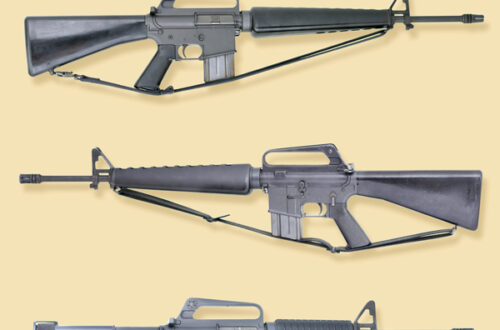Shop
-
WJK 1911
There has been a lot of positive reaction to my Facebook page’s cover picture of “WJK M1911,” one of the two pistols I built with and for “The M1911 Complete Assembly Guide.” I thought some might find this pistol’s background of some interest. The preparation for the Assembly Guide began with attending Larry Vickers’ second-ever M1911-building class. Larry had arranged for the students to begin with Caspian “gunsmith-fit” frames and slides; each frame’s serial number began with “LVP.” My frame was #11, hence “LVP 011.” Unfortunately, a family medical emergency took me away from that class when I was not yet halfway through it. Fortunately, during the photography and writing…
-
The Mysterious Case of the Pachmayr & the Tussey
Some years ago, whilst researching “The M1911 Complete Owner’s Guide,” I came across a Pachmayr custom M1911 in .22 Long Rifle. It was built with a .22/.45 Conversion Unit. Nothing particularly puzzling there, except for one nagging question: what was the source of the frame? Clearly, the frame was produced prior to 1968*, at a time when, while the serial number (if present) of American-manufactured firearms was to be marked on the frame or receiver, the manufacturer was free to place the company name and address and model name anywhere it chose. In the case of automatic pistols, generally, the manufacturer and model were marked on the slide, with the…
-
In My Backyard: Tulle Fusil de Grenadier
One of the most interesting firearms I have had the opportunity to own is a Tulle Fusil de Grenadier. As a lifetime history buff, I knew from a young age that Forbes Road, the 18th century road from Fort Ligonier to Fort Duquesne, passed about two miles south of my home. As a boy it never entered my mind that I would one day own a French musket that may have been carried along Forbes Road. The French & Indian war lasted from 1754 through 1763. In addition to Jumonville Glen, battle sites in my area include Fort Necessity, Braddock’s crossing of the Monongahela River, Fort Duquesne, Fort Pitt, Fort Ligonier…
-
Ruger 10/22 – Ch. 2: STANDARD NOMENCLATURE
Chapter 2: STANDARD NOMENCLATURE Why is Standard Nomenclature Important? During our journey through the world of the 10/22 we’ll be referring to the various components that make up the rifle. It’s important that we use the “language” of the 10/22 as defined by Ruger, so that you, and we, know what we’re talking about. Exactly. NOTE: For many years the author has been deeply involved in the world of the Garand and MI4/MIA. In this world, the language is at times counterintuitive-the “bullet guide,” for example, had nothing to do with guiding bullets and at other times, confusing was that an “op rod guide” or “op rod spring guide” you…
-
Ruger 10/22 – Ch. 9: SELECTING ENHANCEMENTS
Chapter 9: SELECTING ENHANCEMENTS Overview The Ruger 10/22 is a deceptively simple, yet highly sophisticated rifle. Each of its components was designed as it was for a reason, and all the components were designed to work in harmony one with the other. However, because the rifle is a mass-produced product one of the considerations in its design was to manufacture it at a cost that permits a profit when the rifle is sold at a price attractive to consumers. Consequently, many owners believe that the rifle is subject to improvement in various ways. A robust industry supplying the desires of these owners has grown over the years. We shall describe…
-
Ruger 10/22 – Ch. 10: ALMOST 10/22s
Chapter 10: ALMOST 10/22s Ruger’s “Almost 10/22s” ALMOST 10/22®s The Charger In 2008 Ruger produced a surprise, a pistol based on the 10/22. While it was discontinued in 2013 it was reintroduced early in 2014 with a revised stock, a shorter, threaded barrel, and a lower rail with bipod. In addition to the “standard” Charger, a Takedown version with a fitted hard case very “MI-6”-ish was added. PITFALL: Don’t try this at home. US law does not permit cutting a rifle down to pistol size. Thus, you cannot legally take a 10/22 rifle and tum it into a Charger. TIP: However, if you get a stripped clone receiver that has…
-
Ruger 10/22 – Ch. 4 Assembly – Intro
ASSEMBLY, pg. 101 Overview It is tempting to simply state at this point, “Assemble in reverse order.” That’s actually true in the case of the 10/22, but to avoid requiring the 10/22 owner to read the Disassembly chapter backwards, we’ll go through the process here. TIP: Nevertheless, we strongly recommend that you review the Disassembly chapter before proceeding. The more familiar you are with disassembling the rifle, the easier assembly will be. TRIGGER GROUP ASSEMBLY Safety We’ll start with the stripped trigger guard. The first step is to install the safety. TOLD YOU SO: As you proceed to install the safety, you may come to understand why we suggest that…
-
Ruger 10/22 – Ch. 1 History – Intro
HISTORY, pg. 5 The Sturm, Ruger Company What has made the Ruger company one of the largest firearms manufacturers in the country? There are many factors, including fiscal conservatism; but if we were to sum it up in one word, that word would be: innovation. Bill Ruger began with innovation in manufacturing, building on the new ideas and techniques that stemmed from the crucible of World War Two. While the established firearms industry manufacturers resumed their manufacturing with long-standing processes and technologies, bolstered by the legacy lathes and mills left behind by WWII’s War Production Board, the audacious upstarts of the postwar firearms field were unbound by traditions of…
-
M14 Assembly Guide – Table of Contents
Forward………….vii Preface…………ix 1 The Purpose of this Book……..1 2 General Considerations………3 3 Disassembly…………………….5 Before You Start……….5 Basic Field Strip…………5 Detail Strip of Receiver Group………..9 Operating Rod Spring Guide and Operating Rod Spring……………..9 Connector Lock Removal (Optional, not Recommended)…………….9 Operating Rod Removal……………….11 Bolt Removal……….19 Rear Sight Disassembly……………19 Handguard Removal……23 Flash Suppressor Group Disassembly……………………25 Front Sight Removal………25 Flash Suppressor Removal………25 Gas Cylinder Group Disassembly……..29 Gas Cylinder Disassembly…………………………………31 Operating Rod Guide Removal……………………………………..33 Bolt Disassembly…………………………………….35 Barrel Removal………………………………………..37 Barrel Removal: Conclusion…………….40 Disassembling the Trigger Group………………………….44 Magazine Catch……51 Detail Stripping the Stock Assembly………………………53 Buttplate Removal……………………………..53 Stock Ferrule Removal……………………….55 Stock Liner Removal…………………………….55 4 Assembly………………………59 Before You Start……59 Receivers: The Good, the Bad, and the Ugly…………………………….59 Receiver Firing…
-
M14 Complete Owner’s Guide – Table of Contents
Contents CHAPTER 1: READ ME FIRST!…..1 FULL CIRCLE……….1 FULL DISCLOSURE………….1 GROUND RULES and a PET PEEVE……..3 WE WERE NOT ALONE…………..3 CHAPTER 2: A BRIEF HISTORY of the M14……5 PROLOGUE…………5 Imagine It’s December 7, 1941………5 The Genesis of the M14……………….5 Cartridge Development Outside the USA…………..9 Cartridge Development in the USA………..…………11 US Rifle Development………..……….11 From the T20 to the T44 and the M14…….………..13 M14 Design Heritage Summary……….…..17 T44 and M14 Production History………..…..19 Full-Auto Follies………………….19 Changes During Production……….….23 Mel Johnson on the AR-15 versus M14 (GUNS Magazine March 1963)…….24 The Riflemen Leave the Building……….27 “SLAM” Marshall, Hitchman, Hall and Vietnam……..……..29 The M14 Falls Short……………….29 The M14 Hangs On……….…..31 A New War, a New…


































